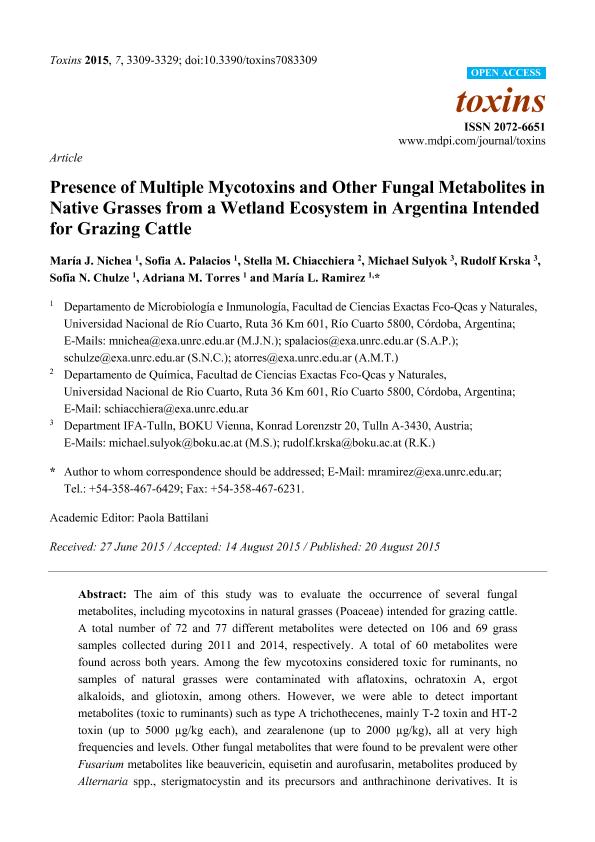Mostrar el registro sencillo del ítem
dc.contributor.author
Nichea, Maria Julia

dc.contributor.author
Palacios, Sofia Alejendra

dc.contributor.author
Chiacchiera, Stella Maris

dc.contributor.author
Sulyok, Michael
dc.contributor.author
Krska, Rudolf
dc.contributor.author
Chulze, Sofia Noemi

dc.contributor.author
Torres, Adriana Mabel

dc.contributor.author
Ramirez, Maria Laura

dc.date.available
2019-02-04T18:07:05Z
dc.date.issued
2015-08
dc.identifier.citation
Nichea, Maria Julia; Palacios, Sofia Alejendra; Chiacchiera, Stella Maris; Sulyok, Michael; Krska, Rudolf; et al.; Presence of multiple mycotoxins and other fungal metabolites in native grasses from a wetland ecosystem in Argentina intended for grazing cattle; MDPI; Toxins; 7; 8; 8-2015; 3309-3329
dc.identifier.issn
2072-6651
dc.identifier.uri
http://hdl.handle.net/11336/69319
dc.description.abstract
The aim of this study was to evaluate the occurrence of several fungal metabolites, including mycotoxins in natural grasses (Poaceae) intended for grazing cattle. A total number of 72 and 77 different metabolites were detected on 106 and 69 grass samples collected during 2011 and 2014, respectively. A total of 60 metabolites were found across both years. Among the few mycotoxins considered toxic for ruminants, no samples of natural grasses were contaminated with aflatoxins, ochratoxin A, ergot alkaloids, and gliotoxin, among others. However, we were able to detect important metabolites (toxic to ruminants) such as type A trichothecenes, mainly T-2 toxin and HT-2 toxin (up to 5000 µg/kg each), and zearalenone (up to 2000 µg/kg), all at very high frequencies and levels. Other fungal metabolites that were found to be prevalent were other Fusarium metabolites like beauvericin, equisetin and aurofusarin, metabolites produced by Alternaria spp., sterigmatocystin and its precursors and anthrachinone derivatives. It is important to point out that the profile of common metabolites was shared during both years of sampling, and also that the occurrence of important metabolites is not a sporadic event. Considering that this area of temperate grassland is used for grazing cattle all year long due to the richness in palatable grasses (Poaceae), the present work represents a starting point for further studies on the occurrence of multi-mycotoxins in natural grasses in order to have a complete picture of the extent of cattle exposure. Also, the present study shows that the presence of zeranol in urine of beef cattle may not be a consequence of illegal use of this banned substance, but the product of the natural occurrence of zearalenone and α-zearalenol in natural grasses intended for cattle feeding.
dc.format
application/pdf
dc.language.iso
eng
dc.publisher
MDPI
dc.rights
info:eu-repo/semantics/openAccess
dc.rights.uri
https://creativecommons.org/licenses/by-nc-sa/2.5/ar/
dc.subject
Bacterial And Fungal Metabolites
dc.subject
Cattle Feed
dc.subject
Fusarium
dc.subject
Grasses
dc.subject
Mycotoxins
dc.subject
Poaceae
dc.subject.classification
Otras Ciencias Biológicas

dc.subject.classification
Ciencias Biológicas

dc.subject.classification
CIENCIAS NATURALES Y EXACTAS

dc.title
Presence of multiple mycotoxins and other fungal metabolites in native grasses from a wetland ecosystem in Argentina intended for grazing cattle
dc.type
info:eu-repo/semantics/article
dc.type
info:ar-repo/semantics/artículo
dc.type
info:eu-repo/semantics/publishedVersion
dc.date.updated
2019-02-04T13:30:17Z
dc.journal.volume
7
dc.journal.number
8
dc.journal.pagination
3309-3329
dc.journal.pais
Argentina

dc.description.fil
Fil: Nichea, Maria Julia. Universidad Nacional de Río Cuarto. Facultad de Ciencias Exactas, Fisicoquímicas y Naturales. Departamento de Microbiología e Inmunología; Argentina. Consejo Nacional de Investigaciones Científicas y Técnicas; Argentina
dc.description.fil
Fil: Palacios, Sofia Alejendra. Universidad Nacional de Río Cuarto. Facultad de Ciencias Exactas, Fisicoquímicas y Naturales. Departamento de Microbiología e Inmunología; Argentina. Consejo Nacional de Investigaciones Científicas y Técnicas; Argentina
dc.description.fil
Fil: Chiacchiera, Stella Maris. Universidad Nacional de Río Cuarto. Facultad de Ciencias Exactas Fisicoquímicas y Naturales. Departamento de Química; Argentina. Consejo Nacional de Investigaciones Científicas y Técnicas; Argentina
dc.description.fil
Fil: Sulyok, Michael. University of Natural Resources and Life Sciences; Austria
dc.description.fil
Fil: Krska, Rudolf. University of Natural Resources and Life Sciences; Austria
dc.description.fil
Fil: Chulze, Sofia Noemi. Universidad Nacional de Río Cuarto. Facultad de Ciencias Exactas, Fisicoquímicas y Naturales. Departamento de Microbiología e Inmunología; Argentina. Consejo Nacional de Investigaciones Científicas y Técnicas; Argentina
dc.description.fil
Fil: Torres, Adriana Mabel. Universidad Nacional de Río Cuarto. Facultad de Ciencias Exactas, Fisicoquímicas y Naturales. Departamento de Microbiología e Inmunología; Argentina. Consejo Nacional de Investigaciones Científicas y Técnicas; Argentina
dc.description.fil
Fil: Ramirez, Maria Laura. Universidad Nacional de Río Cuarto. Facultad de Ciencias Exactas, Fisicoquímicas y Naturales. Departamento de Microbiología e Inmunología; Argentina. Consejo Nacional de Investigaciones Científicas y Técnicas; Argentina
dc.journal.title
Toxins
dc.relation.alternativeid
info:eu-repo/semantics/altIdentifier/doi/http://dx.doi.org/10.3390/toxins7083309
dc.relation.alternativeid
info:eu-repo/semantics/altIdentifier/url/https://www.mdpi.com/2072-6651/7/8/3309
Archivos asociados
